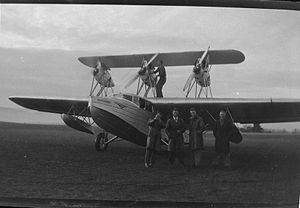Saro Windhover Video - Picture

|
|
Saro A.19 Windhover

Picture - Saunders-Roe Windhover VH-UPB at Launceston, Tasmania
Role: Amphibian
Manufacturer: Saunders Roe
First flight: 1930-10-16
Introduction: 1931
Number built: 2
The Saro A.19 Windhover was a British amphibious aircraft from the period between World War I and World War II, constructed by Saunders-Roe, or Saro. It was originally advertised as the A19 Thermopylae after the famous clipper ship, being an enlarged version of the Saro Cutty Sark.
Development
When tests to improve the power of the Saro A17 Cutty Sark by adding a third De Havilland Gipsy II engine proved impractical (due to the additional weight on the small airframe), Saro designed a larger aircraft on similar lines that could indeed carry three Gipsy II engines. Although a technically successful aircraft and nearly viceless in service, it was a type with a very limited market and only two were built.
Production aircraft
A21/1, prototype first flown at Cowes 16 October 1930, registered ZK-ABW for delivery to Dominion Airways of New Zealand. Aircraft sold before delivery to Matthews Aviation of Melbourne, Victoria and placed on the Australian register as VH-UPB. Between January 1933 and February 1934 operated a regular Bass Strait passenger service between Melbourne and Launceston, Tasmania via King Island. In May 1936 it was damaged beyond repair when blown ashore at King Island while on a charter with a party of game hunters. Although it was salvaged it never flew again, and is believed to have been used as an instructional airframe in Melbourne during the Second World War before being demolished.
A21/2, first and only production example, completed July 1931. After modifications (addition of auxiliary winglet over engines to improve air flow and lift), it was sold to Francis Francis as G-ABJP, who onsold it in September to Gibraltar Airways for the Gibraltar-Tangier route. In July 1932, it was sold to The Hon Mrs Victor Bruce and named City of Portsmouth. The undercarriage was temporarily removed, and during August 1932, it was used in three attempts to break the world flight-refuelled endurance record. That was not achieved, and in May 1935, the aircraft was sold to Jersey Airways, being taken out of service in 1938.
Specifications (A17)
Data from Peter London, Saunders and Saro Aircraft Since 1917, Putnam (Conway Maritime Press), London, 1988
General characteristics
Crew: two, pilot and (optional) co-pilot
Capacity: 4 to 6 passengers
Length: 41 ft 4 in (12.6 m)
Wingspan: 54 ft 4 in (15.56 m)
Height: ()
Empty weight: 4,180 lb (1,860 kg)
Loaded weight: 5,500 lb (2,450 kg)
Powerplant: 3x— De Havilland Gipsy II, 120 hp (90 kW) each
Performance
Maximum speed: 100 knots (110 mph, 185 km/h)
Service ceiling: 10,020 ft (3,055 m)
Lewis, Peter. 1970. British Racing and Record-Breaking Aircraft. Putnam ISBN 0370000676
London, Peter. 1988. Saunders and Saro Aircraft Since 1917, Putnam ISBN 0-85177-814-3
Saro Windhover Pictures
More airplane videos.
Source: WikiPedia